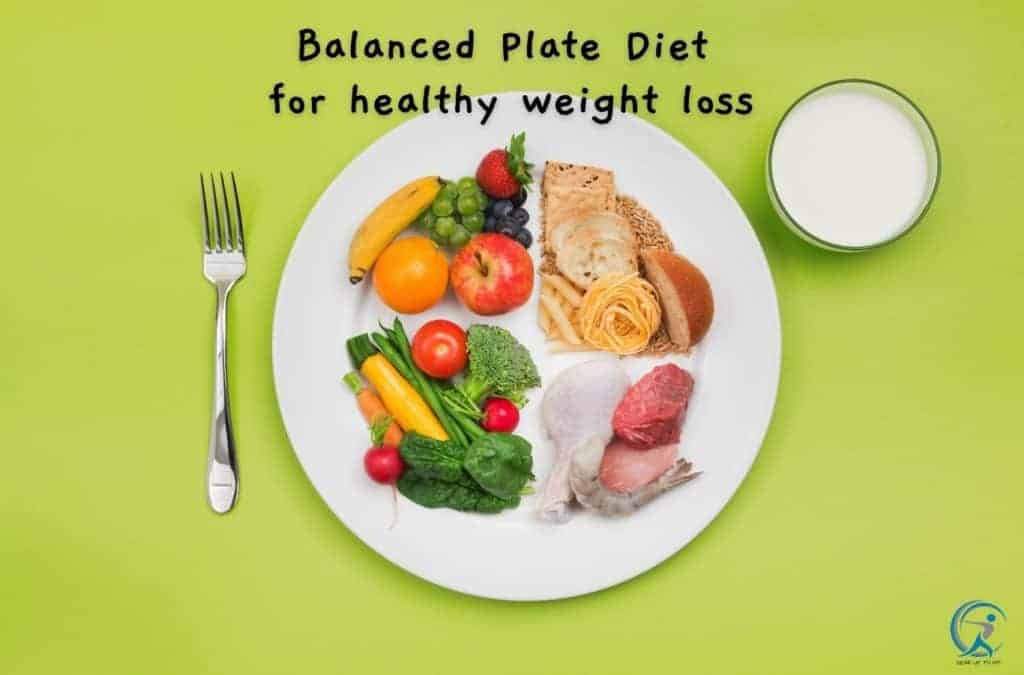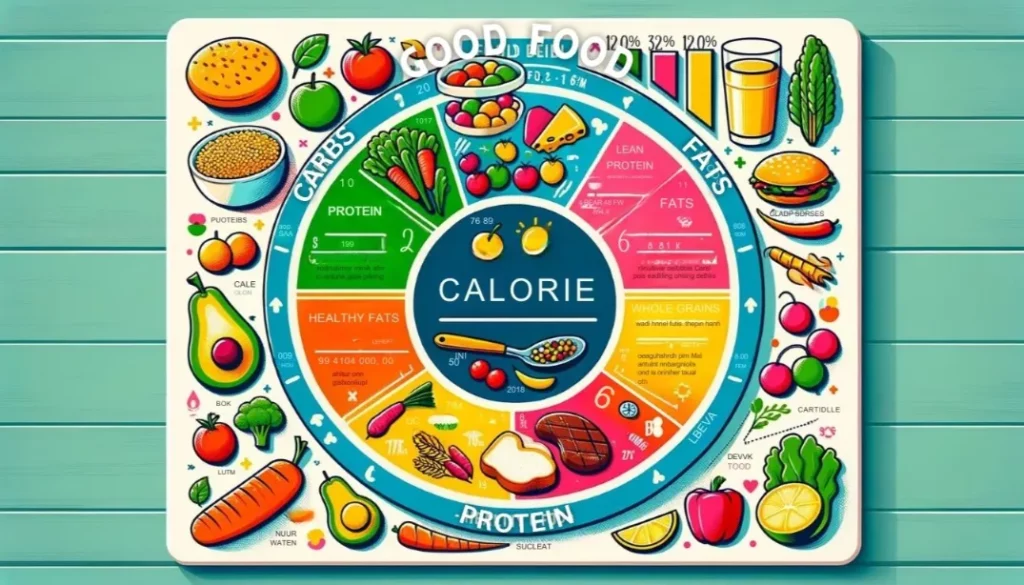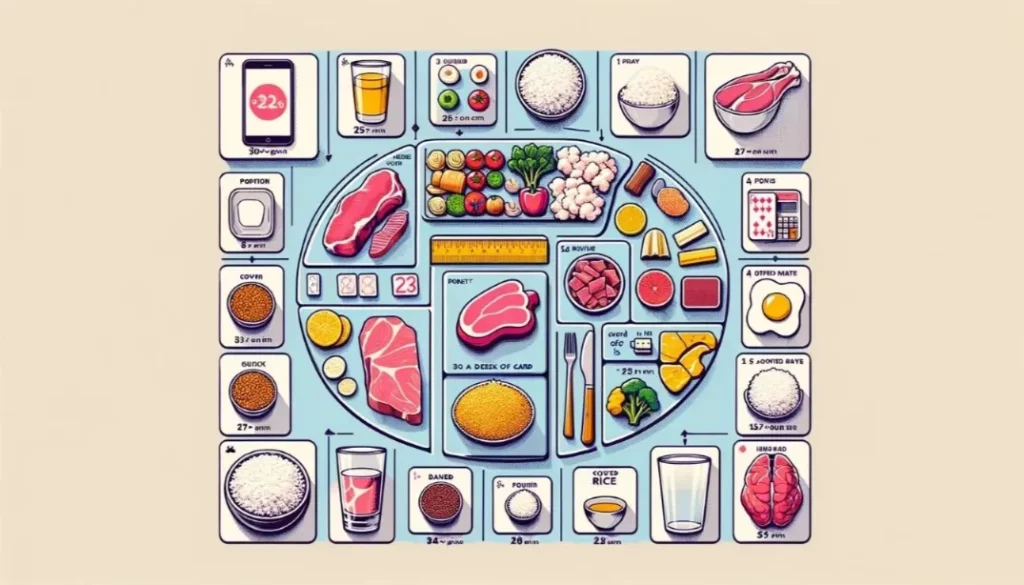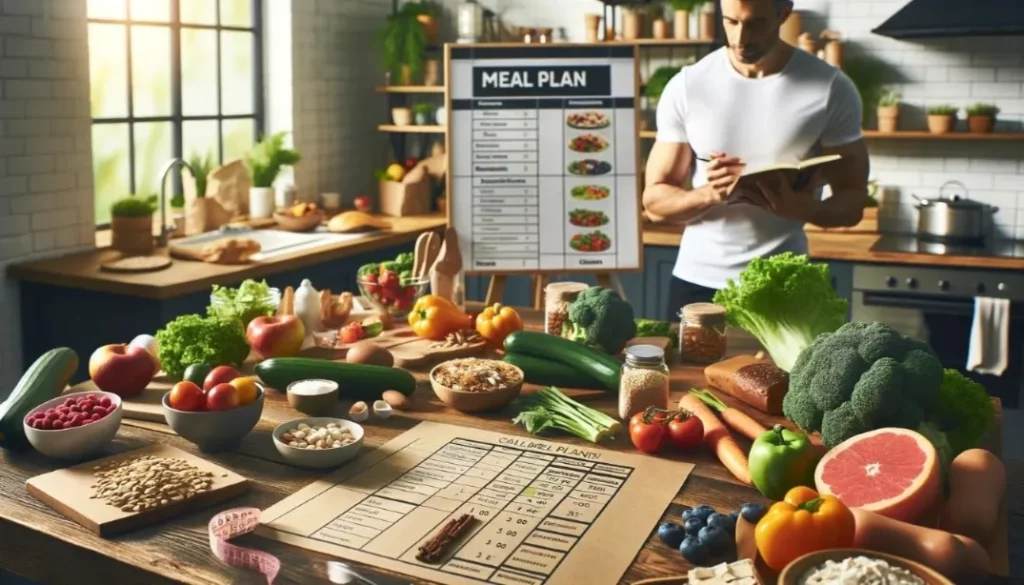Are you ready to shed those extra pounds and take control of your health? A calorie counter meal planner is the ultimate tool for achieving your weight loss goals. Learning about weight loss, healthy eating, and calorie control can help you succeed. This guide will help you learn about meal planning, with a focus on controlling calories for healthy eating and weight management.
Meal planning with calorie control involves more than just counting calories. It’s about understanding the role of macro and micronutrients, incorporating physical activity, and making smart food choices. We will explore the basics of calorie control, from understanding the concept of calories and determining your daily calorie needs to create a customized calorie-controlled meal plan.
Get useful tips and strategies for meal prep, making smart food choices, and overcoming common challenges. These tools will help you succeed in your weight loss journey. Learn how to plan meals with calorie control for a sustainable and effective way to eat healthy and manage weight.
Personalized Meal Planner: Your Guide to Healthy Eating and Calorie Control
Understanding the Basics of Weight Loss and Healthy Eating
Embarking on a weight loss journey can feel overwhelming, yet understanding the basics can make the process much simpler. The cornerstone of any effective plan is regular meal timing, which includes balanced meals and snacks. This routine can curb overeating and improve adherence to your dietary plan.
Aligning your breakfast with your eating habits is important. Adding unnecessary calories in the morning may not support your weight loss goal. Instead, focus on foods that are high in fiber and protein. Research has shown that these nutrients can help with weight loss and should be the main components of a healthy and balanced diet.
To cut back without missing out on vital nutrients, steer clear of highly processed foods, fast food, refined carbs, and fried foods—these can impede weight loss and harm overall health. A good strategy for weight loss is to have a meal plan that fits your daily calorie goal, which could be around 1,200 calories. This can help you lose 1 to 2 pounds per week steadily and moderately.
Losing weight is a personal process. It is important to consider your activity level, food preferences, and nutritional needs when creating your meal plan. By prioritizing portion control and balanced meals, you’re setting the stage for successful, healthy weight loss.
Planning Your Meals for Success

Meal planning is key to achieving nutritional goals and staying healthy. It helps you get the right balance of vitamins and minerals, supports weight loss, and improves overall health. By organizing your meals for the week, you can control your calorie intake and ensure you meet your macronutrient targets. This helps you avoid eating unhealthy food on impulse.
A 1,300-calorie diet suits those who are less active. On this diet, it’s crucial to count calories accurately. Planning meals with the right macronutrients enhances nutrition and helps maintain muscle. Understanding what your body needs from proteins, fats, and carbohydrates is part of this process. Cooking at home encourages healthier eating by cutting down on high-calorie, low-nutrient convenience foods.
Using tools such as MyPlate Plan or My Food Diary can make it easier to track what you eat. These tools help you stick to your meal plan. But meal planning isn’t just about nutritious eating. It ensures you get all the necessary nutrients, helps manage your energy, and can save money. Plus, it helps reduce the amount of food you throw away.
Creating a Grocery List for Healthy Eating
Writing a grocery list is a key part of planning meals and can affect how well your diet works. Health experts say that if you shop with a list, you are more likely to pick healthy foods and lose weight. The list also stops you from buying on impulse, which can lead to unhealthy choices.
Diet plans, like intermittent fasting, keto, Atkins, and high-protein diets, often come with their grocery lists.
Meal Planning and Prepping for Success
Meal planning apps make it easier by creating meal plans and grocery lists that fit your diet requirements. Start with basic cooking skills and create a detailed shopping list. Use smart shopping tips and follow a set routine to prepare your food. This will simplify your cooking process. If you’re on a 1,300-calorie diet, or any diet with calorie limits, plan your meals carefully. You need to get enough vitamins and minerals. It’s important to reach your calorie and protein targets.
Cooking your meals in advance helps maintain consistent energy levels. It also saves you both money and time. Preparing your meals early means you’ll stick to your diet. You won’t have to make quick decisions about what to eat, which can be stressful.
Utilizing a Meal Plan Generator for Customized Meal Plans
Meal plan generators are easy-to-use tools. They create meal plans based on your calorie and nutrient needs. You can customize these plans a lot or a little. Some let you control your entire diet, while others give you ready-made meal plans.
Using a meal plan generator can make meal planning easier. It gives you tailored meal ideas and shopping lists. This helps if you want a planned diet but don’t have time to create one. You might also be able to change meals or days in the plan, so it fits your tastes and life.
Using meal planning tools and techniques, such as making grocery lists and preparing meals in advance, helps you eat healthier. This can lead to better weight control. These tools and methods are helpful whether you want to lose weight or just improve your diet. They make managing your food simpler and support your health goals.
Understanding Your Macro and Micro Nutrients
Macronutrients and micronutrients are key to a healthy diet. They both play important roles in keeping you healthy. Macronutrients, or macros, are proteins, carbohydrates, and fats. They help repair muscles, provide energy, and make hormones. To keep your muscle mass while losing weight, you should eat enough protein. Aim for 0.8 to 1 gram of protein per pound of your body weight. This helps you look toned, and your metabolism works better.
Micronutrients include vitamins and minerals. They are important for a strong immune system, healthy bones, and preventing long-term illnesses. Eat plenty of fruits, vegetables, whole grains, lean proteins, and healthy fats to get these nutrients. By getting the right balance of macros and micros in your diet, your body works at its best. This supports your health and fitness goals in the long run.
The Importance of Balanced Meals and Portion Control

Creating balanced meals with proper portion sizes is key to controlling calorie intake without sacrificing nutrition. It’s important to include a variety of food groups to make sure you’re obtaining the necessary macro and micronutrients. Eating smaller portions helps control the number of calories you consume, ensuring that you eat a balanced diet without overeating.
Balanced meals typically consist of:
- Lean proteins: Chicken breast, lean beef, or low/no-fat Greek yogurt
- Whole grains: Brown rice or whole-grain pasta
- Healthy fats: Avocado or nuts
- A variety of vegetables: Mixed greens or sweet potatoes
- Fruits for fiber and vitamins: A medium apple or banana
To lose weight and stay healthy, it’s important to know the nutritional value of foods and manage portion sizes.
Incorporating Macronutrients into Your Meal Plans
Integrating macronutrients thoughtfully into your meal plans ensures you reach your nutritional targets. For a 150-200 lb individual aiming for 100g of daily protein, lean proteins are a must. Yet, supplementary protein can be found in everyday foods such as bread, pasta, and even Cheddar cheese.
A macro meal planner makes reaching your protein, carb, and fat targets easier without manual math. Pro subscriber tools let you customize recipes, make grocery lists easily, and scan barcodes for unplanned items.
If you prefer simple options, choose weekly meal plans designed around macros. These plans offer balanced, varied diets, so you can enjoy meal planning as part of a healthy lifestyle.
Implementing Physical Activity into Your Weight Loss Journey

Exercise is key to losing weight. It burns calories and improves mood while lowering the risk of long-term illnesses. Begin with easy exercises like a 30-minute walk three times a week. This small step is easy to do, doesn’t need special gear, and starts a more active life.
As you get fitter, add different and harder exercises to your routine. Try biking, swimming, hiking, or jogging to stay interested and push yourself. These workouts help you lose weight and gain muscle. More muscle means more fat-burning and a faster metabolism.
Working out with a diet makes losing weight more effective. It also boosts your well-being and sense of achievement, which keeps you motivated. Regular exercise and healthy eating are the foundation for keeping weight off and improving your health.
Finding the Right Physical Activity Level for You
It’s important to pick an exercise routine that fits your lifestyle, preferences, and fitness level. This helps you stick to it and see results. The MyPlate Plan calculator can help you find the right level of activity. It uses your age, sex, weight, and how often you exercise. But remember to listen to your body. If you’re new to working out, make sure not to push too hard too fast. This can prevent burnout and injuries.
As you get used to exercising and get fitter, you can slowly make your workouts harder. This will make them more effective. You can go from walking to jogging, or start lifting weights. These changes can improve your health and help you lose weight faster. Choosing an exercise that you enjoy is also key. This makes you more likely to do it regularly.
Remember that change takes time. It comes with regular effort and commitment. Don’t just focus on your weight to track progress. Also, look at how your fitness improves. Watch for signs like being able to exercise longer, having stronger muscles, and being more flexible.
Balancing Diet and Exercise for Maximum Results
To lose weight effectively, you need a good balance of diet and exercise. Various cuisines, like Traditional, Asian American, Southern, Mexican-American, and Lacto-Ovo Vegetarian, suggest eating 1,200 to 1,600 calories a day. These meals fit different tastes and can help with weight loss. They work best when combined with regular exercise.
People who weigh more or exercise a lot may need 1,500 to 1,800 calories a day. This is because they burn more energy. However, diets under 800 calories are very low and should only be done with a doctor’s guidance. Low-calorie diets can be risky and might not meet your body’s nutritional needs.
To keep losing weight, check your weight regularly and adjust how much you eat as needed. Avoid eating too little or becoming stuck at the same weight. To lose weight and maintain it, consume fewer calories, focus on nutrient-rich foods, and stay physically active.
Remember, before you start a new diet or exercise plan, talk to a doctor or nutritionist. They can help create a plan that’s right for your health, tastes, and how you live.
The Basics of Calorie-Controlled Meal Planning

Calories are the energy we get from our food and drinks. They are essential for weight management. If we eat more calories than we use, our body stores the extra fat. This causes weight gain. If we eat fewer calories than we use, we lose weight. This is the basic rule for controlling calories to manage weight.
When trying to lose weight, remember that the quality of calories matters, not just the amount. Choose foods low in calories but rich in vitamins and minerals for healthier weight loss. A balanced diet with a variety of foods is important. It ensures you get the nutrients you need, even when watching your calorie intake.
Determining Your Daily Calorie Needs
Everyone’s daily calorie needs are different. They are determined by age, gender, weight, height, and how active you are. These factors determine your calorie needs for maintaining, losing, or gaining weight. Adult women usually need between 1,600 and 2,400 calories a day. Men usually need between 2,000 and 3,200 calories a day.
If you want to lose weight, aim to lose about 1 pound a week. This means eating 500 calories less per day. But, calorie goals should be made just for you. Diets with less than 800 calories a day are dangerous without a doctor’s care.
Use online tools and meal planners to estimate how many calories you need. But, it’s best to talk to a doctor or dietitian. They can make sure your calorie intake is safe and works for you, considering your health and goals.
Your calorie needs change, especially if you lose weight or exercise more. So it’s important to check regularly and make changes as needed. Meal plan generators and planners can be incredibly helpful in organizing and planning meals. They keep track of your personal calorie and nutrient needs. Plus, they take into account what foods you like. This makes planning meals easier.
How to Calculate Your Caloric Requirements

To customize your diet for your energy needs, it’s important to calculate your caloric requirements. This is especially important if you want to maintain, lose, or gain weight. It begins with understanding two key concepts:
Basal Metabolic Rate (BMR) and Total Daily Energy Expenditure (TDEE). Here’s a simplified breakdown:
- BMR is the energy your body needs to function at rest.
- TDEE takes your BMR and adds the calories you burn through daily activities and exercise. It’s the total number of calories you burn in a day, and you’ll need to know it to manage your weight effectively.
To calculate your TDEE, a widely used method is the Mifflin-St. Jeor Equation. The Mifflin-St. Jeor Equation is a popular method for calculating your Total Daily Energy Expenditure (TDEE). It uses your weight, height, age, and gender as inputs. This equation is presented as:
For men: BMR = (10 × weight in kg) + (6.25 × height in cm) – (5 × age in years) + 5 For women: BMR = (10 × weight in kg) + (6.25 × height in cm) – (5 × age in years) – 161
After determining your BMR using the equation, you will multiply the number by an activity factor to find your TDEE. The activity factors are generally categorized as follows:
- Sedentary (little or no exercise): BMR × 1.2
- Lightly active (light exercise/sports 1-3 days/week): BMR × 1.375
- Moderately active (moderate exercise/sports 3-5 days/week): BMR × 1.55
- Very active (hard exercise/sports 6-7 days a week): BMR × 1.725
- Extra active (very hard exercise & a physical job): BMR × 1.9
Many online calculators can do the math for you. You just have to enter your personal details. These calculators give you a fast estimate. For the most precise measurement, especially for individuals who are excessively overweight or have high muscle mass, it is advisable to consider undergoing an RMR test. Have this test done by a medical or fitness professional for the best results.
Adjusting Intake for Weight Loss
First, calculate your Total Daily Energy Expenditure (TDEE).
If you want to:
- lose weight, and eat fewer calories than your TDEE.
- gain weight, eat more.
- maintain, eat the same amount.
- lose body fat, create a calorie deficit by eating less than what you burn each day.
Reduce your daily calorie intake by 500 to lose about 1 pound per week. This is a safe rate of weight loss. Make sure not to eat too little. Women should consume 1,200-1,500 calories a day. Men and active women should aim for 1,500-1,800 calories a day. This promotes healthy weight loss.
Avoid very low-calorie diets of fewer than 800 calories a day unless a doctor is watching you closely. They can be risky. Balance your diet so you have a calorie deficit but still get the nutrients you need. This will keep you healthy and active.
Adjust your diet based on your weight loss goals and TDEE. Eat lean proteins, whole grains like brown rice, lots of vegetables, and healthy fats. Substituting egg whites for whole eggs and adding low-calorie vegetables are tricks to stay full without eating too many calories.
Plan and prep your meals. This helps you manage your calorie intake and avoid last-minute food choices that may not be healthy. Control your portions and prepare your food in advance. This helps you stick to your calorie goals.
Creating Your Calorie-Controlled Meal Plan
Creating a calorie-controlled meal plan involves balancing your individual needs with your food preferences. This can help you reach your weight goals. Meal planning apps, like Meal Prep Pro, make it easier. They let you set daily calorie targets and adjust recipes to match those goals. Herbalife Nutrition also helps by providing structured meal plans. These are designed for those who want to maintain, lose, or gain weight. They include suggested meals, snacks, and shakes that meet your daily nutrition needs.
It’s important to talk to healthcare professionals before starting any meal plan. This is to make sure your plan includes all the vitamins and minerals you need every day. Verywell suggests this step. MyDietMealPlans offers additional help by automatically creating shopping lists and meal plans. These match your personal nutrition goals, making it easier to keep track of your macros and calories. You can also turn these plans into PDFs. This makes them easy to use and stick to.
With these tools, making a balanced and enjoyable meal plan becomes easier. They help keep you on track with your health goals. Whether you’re trying to lose weight, build muscle, or just be healthier, these plans ensure each meal helps you on your journey.
Structuring Meals and Snacks for Balance and Satisfaction
When planning meals with calorie control in mind, it’s important to include structured meals and snacks. This helps balance nutrition and keeps you feeling full. You need a good mix of proteins, fats, and carbohydrates for balanced meals. Herbalife shows this by offering protein-rich snacks and Formula 1 shakes. Make sure your meals have all food groups to meet your nutritional needs and control hunger between meals.
Also, when you eat meals and snacks, matters for diet success. Breakfast is linked to a healthy lifestyle. When adding breakfast, remember to count its calories. Meal plans like Herbalife’s include breakfast to start your day strong and full of energy.
An additional consideration is the caloric content of beverages and the hidden sugars in processed foods. Alcohol consumption can also significantly increase daily calorie intake and thus should be factored into the overall plan. Being attentive to these often-overlooked aspects can prevent unintended calorie surplus and support weight loss efforts effectively.
Portion Sizes and Measuring Your Food
Understanding and managing how much you eat is key to a diet that controls calories. A “portion” is how much food you choose to eat, which can be more than a “serving size” on a food label. If you’re on a 1,300-calorie diet, use cups, spoons, or scales to measure food accurately. This is important for controlling portions.
Measuring food is crucial, particularly when you enjoy your favorite foods while on a low-calorie diet. It keeps your calorie count precise and helps your diet succeed. If you need to change your meal plan, use measuring tools to adjust food amounts. For example, you might alter portions by 20% for either a 1,800 or a 1,200-calorie diet.
Nutrition apps are very helpful. They are the easiest way to keep track of what you eat daily, manage calories, and meet nutritional goals. You’ll create a strong basis for losing weight or reaching health goals by carefully tracking and controlling portions.
The Role of Macronutrients in Meal Planning
When you start planning your meals, you need to know about macronutrients. These are proteins, carbohydrates, and fats. They are important because they give your body the nutrients it needs to work well. Macronutrients provide energy and help keep you healthy.
If you weigh between 150-200 pounds and want to consume 100g of protein each day, proteins are key. They help repair and grow your muscles. Carbohydrates give you energy for all you do during the day. Fats help your body absorb vitamins and keep your hormones in balance.
Proteins and carbohydrates have about 4 calories in each gram. Fats have about 9 calories per gram. Paying attention to these macronutrients is important for controlling your calories. That’s why they’re so necessary in meal planning.
Understanding Proteins, Carbohydrates, and Fats
For a balanced meal plan, you need to know about proteins, carbohydrates, and fats, and the calories they provide. Add good protein sources to your diet, such as chicken breast, lean beef, and low-fat or fat-free Greek yogurt. This will help you fulfill your daily protein requirements. Get your carbs from foods high in fiber such as whole grains, veggies, and fruits. These will keep your energy up and help your digestive system. For fats, choose foods like nuts, avocados, and olive oil. They offer concentrated calories and help your body absorb nutrients.
Each macronutrient fulfills a specialized function in the body:
- Proteins: Build and repair tissues and are vital for muscle maintenance and growth. Proteins are essential for building and repairing tissues, as well as for muscle maintenance and growth.
- Carbohydrates: Act as the primary energy source for body functions and physical activity.
- Fats: Play a key role in hormone production and help absorb fat-soluble vitamins (A, D, E, and K).
Tracking the macro breakdown in your meals helps you make smart food choices and manage your intake. It ensures your meal plans are rich in nutrients and match your calorie and macro goals.
How to Distribute Macronutrients Throughout the Day
For sustained energy and overall health, it’s beneficial to distribute macronutrients evenly throughout the day. This requires incorporating a mix of protein, carbohydrates, and fats in each meal. Research suggests that integrating a protein source with fiber-rich carbohydrates can enhance satiety and prevent overeating. Here’s a simple guideline for balancing macronutrients in meals:
| Meal | Protein | Carbohydrates | Fats |
|---|---|---|---|
| Breakfast | Egg whites | Oatmeal | Avocado |
| Lunch | Grilled chicken | Mixed greens | Olive oil dressing |
| Dinner | Salmon | Quinoa | Steamed vegetables |
To balance your macronutrient intake and meet your dietary needs, include lean proteins, complex carbohydrates, and healthy fats in each meal. This will also support weight management. Remembering that whole foods should dominate the plate ensures you gain all the micronutrients needed alongside your macros.
In conclusion, macronutrients are the cornerstones of a calorie-controlled meal plan. Knowing the calories and health benefits of proteins, carbohydrates, and fats is crucial for a balanced diet that keeps you energized and supports your body’s functions.
Smart Food Choices for Calorie-Controlled Diets
A 1,200 calorie meal plan is often suitable for women seeking to shed pounds and manage their food intake effectively. Men need more energy than women, so they should follow a diet with a higher daily calorie intake. Counting calories is a flexible method for losing weight. It gives people the freedom to choose foods and drinks that fit their calorie goal.
Nutrient-Dense Foods vs. Empty Calories
In selecting the right foods for a calorie-controlled diet, it’s essential to distinguish between nutrient-dense and empty-calorie foods. Fresh fruits and vegetables are full of vitamins, minerals, and fiber, and they have fewer calories due to their high water content.
| Nutrient-Dense Foods | Empty Calorie Foods |
|---|---|
| Fresh fruits | Sugary sodas |
| Leafy greens | Candy |
| Lean proteins | Crisps |
| Whole grains | Pastries |
‘Empty calorie’ foods have many calories but few essential nutrients, usually because of added sugars and fats. For instance, whilst crisps and dried fruits supply more calories, they offer fewer health benefits than their fresh counterparts. When making a low-calorie diet, eat foods that are rich in nutrients to feel full and only have small portions of high-calorie foods occasionally.
Building a Calorie-Controlled Grocery List
Start with smart shopping! Here’s a simple guide to picking the best low-calorie foods at the store:
Fresh Fruits and Veggies:
Stock up on all the colorful fruits and veggies you can find. They’re not just low in calories—they’re full of the good stuff your body needs.
Protein, But Make It Lean:
Think skinless chicken, fish, egg whites, and beans. They help you build muscle without packing on the pounds.
Whole Grains for the Win:
Swap out white rice for brown rice, and get your hands on some quinoa and whole-wheat goodies. They keep you going longer without the calorie spike.
Fats, But Keep ‘Em Healthy:
Yes to avocados, nuts, and a drizzle of olive oil. Just remember—a little goes a long way!
Dairy: Go Low or No Fat:
Grab some Greek yogurt or skim milk. You’ll still get that dairy goodness without all the calories.
Stick to this list, and you’ll be on your way to making choices that can help you slim down while staying healthy. Happy shopping!
Using meal-planning apps can simplify the process significantly. These tools automatically compute nutritional values and generate shopping lists to match your meal plans. They can also provide recommendations for daily calories and other guidelines based on personal weight and health goals. These suggestions can easily be integrated with health-tracking apps to create a comprehensive diet management system. They help you stick to a low-calorie diet that is nutritious and satisfying, making it easier to reach your weight loss goals with confidence.
Meal Planning Strategies for Busy Lifestyles

Prepping Meals in Advance
Meal prepping saves time and helps you stick to your diet. Choose a day, like Sunday afternoon, to cook and portion your meals for the week. Use meal planning apps to create a plan that fits your calorie and diet needs. These apps can adjust to your activity level if they work with Apple Health or Google Fit.
Write down your weekly meals and snacks. Focus on your macronutrients and calories. Include enough protein (0.8-1g per pound of body weight), healthy fats, and complex carbs. This balance will keep you full and meet your nutritional goals. Then, create a grocery list that matches your meal plan and portions.
Choose simple and delicious recipes when cooking. Batch-cook foods like brown rice, grill chicken breasts, or make a big salad. These can be mixed and matched throughout the week. After cooking, divide the food into portions and store them in the fridge or freezer. Now you can quickly grab meals as needed.
Quick and Healthy Meal Ideas
When you have busy days, it’s important to have quick, healthy meal ideas ready. Make a grocery list with basic items that you can mix quickly. These meals should be tasty, fit your calorie needs, and be quick to make.
For example, a Simple Salmon Salad is great. It has omega-rich fish, greens, and cheddar cheese. You can pack it early for a hearty lunch. Or, try a Mediterranean Chicken Platter. It has pre-cooked chicken, brown rice, and fresh veggies. It only takes minutes to put together.
Include high-fiber foods like sweet potatoes, black beans, and quinoa. These help you stay satisfied and curb your cravings. Eat fruits like apples or bananas as snacks or desserts. They’re sweet but low in calories.
Planning and prepping meals helps you stay healthy. They’re key for losing weight, saving time, and solving the daily dinner problem. With these tips, busy people can stick to a calorie-controlled diet that fits their busy lives and health goals.
Overcoming Common Challenges in Calorie-Controlled Meal Planning
Embarking on a calorie-controlled meal plan may pose some straightforward challenges. However, you can easily solve these problems with good strategies. If you don’t plan your diet, you might eat more calories, which can slow down your weight loss. Planned meals help to keep you on your planned path. A personalized meal plan can make counting calories more enjoyable by offering delicious, nutritious food options.
Meal planning apps are a fantastic way to dramatically enhance the meal planning process. They offer custom options that consider what you like and your dietary requirements. Apps like Meal Prep Pro have a feature that lets you balance the variety of meals with the time you have to cook. This is great for busy people who still want to eat different meals.
Dealing with Hunger and Cravings
Hunger and cravings can sabotage a good diet. To reduce hunger on a low-calorie diet, choose foods that fill you up with fewer calories. Fish and chicken are lean proteins that help control appetite. Pair them with fresh, frozen, or canned fruits and vegetables. These are better than dried or crisped versions because they have more water and fewer calories.
Eating six meals a day can also help. It spreads out your food intake, keeping hunger and energy stable. However, it’s important to talk to a healthcare provider or dietitian. They can tailor the meal plan to fit your specific needs.
Dining Out and Social Events
You don’t have to avoid eating out or going to parties on a calorie-controlled diet. You can still enjoy going out and staying true to your diet. Just plan before you go. Check the restaurant’s menu online and pick healthy choices that fit your 1,500-calorie diet. Choose meals with lots of vegetables, protein, and fiber. This way, you can have a satisfying meal without messing up your diet.
Consider these low-calorie dining tips for success:
- Opt for grilled or steamed dishes over-fried.
- Request dressings and sauces on the side to control the amount you consume.
- Split entrées or save half for later to keep portions in check.
- Savvy substitution is your friend—swap out calorie-dense sides for a garden salad or extra veggies.
At any fun gathering, keep to your healthy eating habits. Pick your food carefully. Focus on the people, not just the food. Make sure to plan and practice self-control. This way, you can enjoy social events without breaking your daily calorie limit. It fits well with a plan for a healthy, balanced life.
Monitoring Progress and Making Adjustments
Track your health and diet to stay motivated. Meal planning apps with tracking tools help you manage your diet well. Enter your weight, body fat, and waist size weekly to see your progress visually. This keeps you motivated and helps you stick to your diet.
Use custom measurements for specific health goals in the app’s ‘My Progress’ section. Track your weight loss, body fat reduction, or waist trimming. Seeing your own progress boosts your dedication to a healthy lifestyle.
Progress tracking in the app also makes grocery shopping easier. It generates a PDF list for you to download. With this list, you shop efficiently, ensuring you get what you need for your healthy meal plans.
Keeping a Food Diary
Keeping a food diary is a good way to stick to a healthy diet. Writing down what you eat helps you understand your eating habits. It helps you control calories and lose weight. You can use a journal or an app to track your meals, snacks, drinks, and their calories. This helps avoid underestimating how much you eat, which many people do.
It is important to use food tracking wisely, though. Being too strict with counting calories can harm your relationship with food. You should also focus on other healthy habits. These include controlling portion sizes, eating whole foods, being mindful while eating, and staying active.
When and How to Adjust Your Meal Plan
Your diet should change as you do. Update your meal plans, calories, and nutrients to match new goals or situations. Use apps to set personalized targets for health or weight objectives.
If you’re not progressing, changing how active you are or your lifestyle may impact your diet, so you might need to make adjustments to your meal plan. A Meal Plan Selection Tool can recommend the ideal plan – options A, B, C, or D. It uses your sex, weight, and height to guide you. The tool ensures you eat right for your body and preferences. Meal plans can be flexible to match your life changes. They can also adjust servings when you cook for others, so you buy the right amount of food. The ‘Meal Plan Chart’ shows you a daily mix of meals, snacks, and shakes. It helps you see the variety and adjust your diet daily.
Conclusion
Meal planning with calorie control helps you lose weight and improve your health. This guide has shown you how to plan meals, control calories, and eat healthily. Learn about nutrients, exercise, and making good food choices to create a lasting and successful diet.
Understand the need for balanced meals, proper portion sizes, and spreading out nutrients during the day. Make a grocery list that matches your diet goals. Meal planning and preparation are key. The guide provides tips for fitting meal planning into a busy life.
The guide recommends tracking your diet, adjusting your meal plan, and keeping a food diary for an accurate diet. Be ready to change your meal plan as needed, depending on your situation or new goals.
By using these methods every day, you can follow a diet that manages calories, aids weight loss, and contributes to a healthier life. Each step towards better eating and weight control is a big leap for lifelong health and energy.
